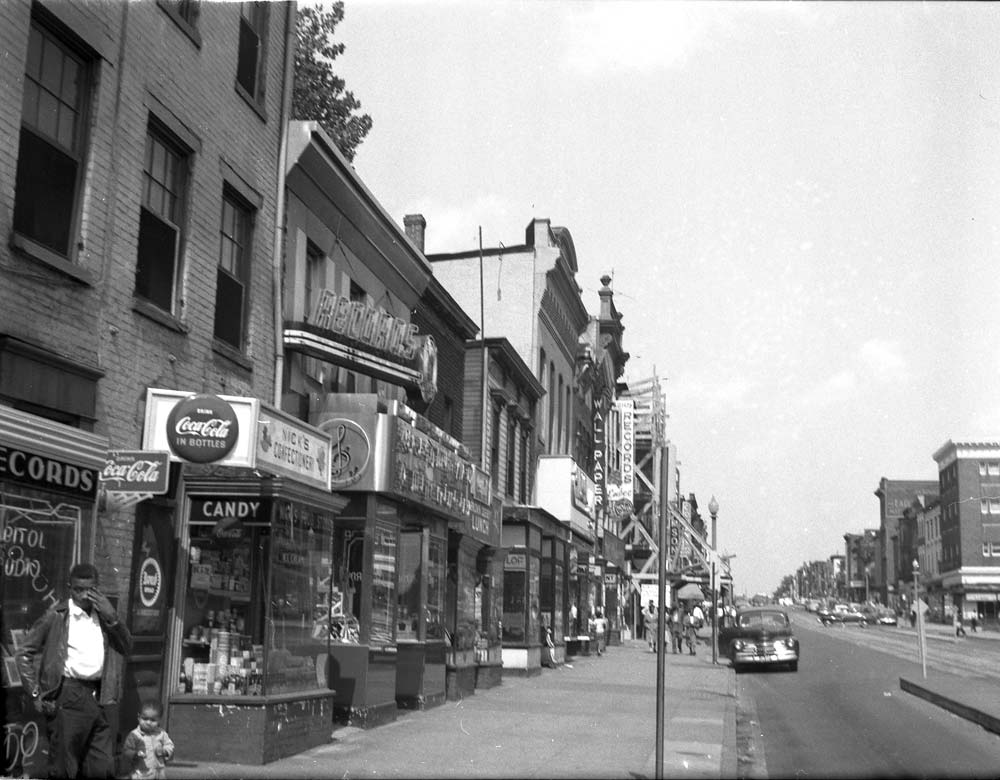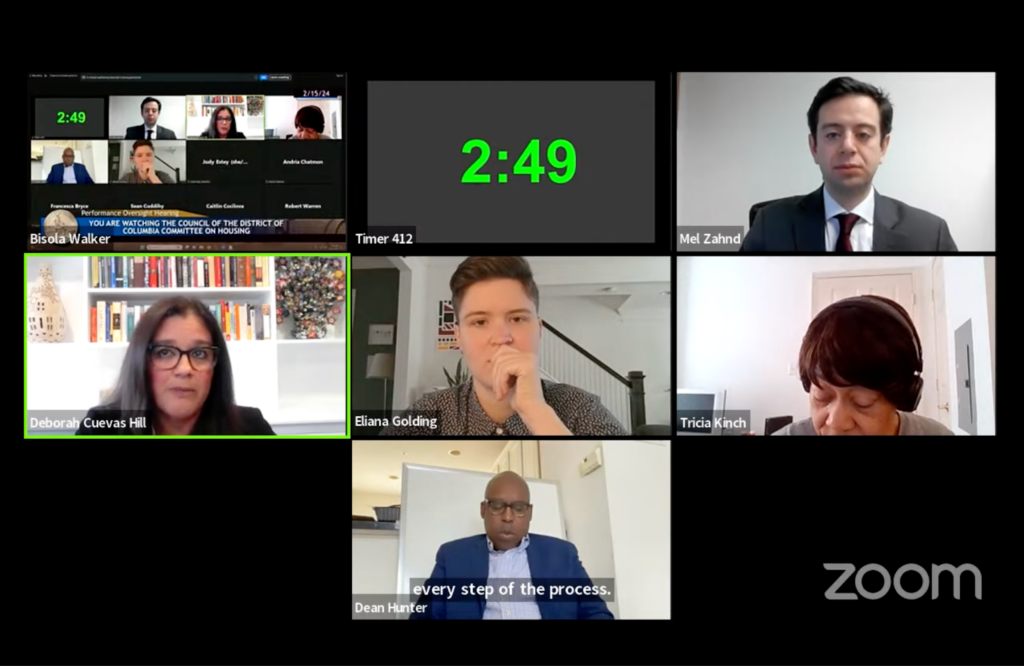On May 11, Apple Inc. completed its most extensive historic renovation to date and opened its new Carnegie Library location to the public. Overall, the public and local press greeted the grand opening with enthusiastic reviews. People raved about the care put into the restoration and praised efforts that went into revitalizing Mount Vernon Square. A few naysayers critiqued the privatization of the building that formerly housed the central branch of the D.C. Public Library. But few acknowledged the role the library’s revitalization played in the long process of gentrification that displaced the once vibrant, predominantly African-American neighborhoods surrounding the square.
And this was not the first community the Carnegie Library has played a role in destroying. The library, in its 113-year history, has twice marked the culminating moment in the destruction of a neighborhood – first with its initial construction and now with its most recent restoration.
The Mount Vernon Square neighborhood first began to take shape in the 1840s with the construction of the Northern Liberty Market. By the mid-19th century, the area had become a predominantly immigrant and African-American, working-class neighborhood centered on the market. In 1857, the Know-Nothing-Party or American Party, which was staunchly anti-immigrant, targeted the bustling Mount Vernon neighborhood by sending street gangs to the area to intimidate voters. This provocation led to the outbreak of the Know-Nothing Riots, which left six people killed and twenty-one injured. The Know Nothings unsuccessfully hoped to undercut the political strength of this community.
Where the Know Nothings failed, city officials and developers would succeed. Fifteen years later, in 1872 the city government passed a bill authorizing the destruction of Northern Liberty Market. While many of the adjacent landowners petitioned for the closure, citing poor sanitation and “a most disagreeable stench,” vendors and patrons of the market vehemently protested the decision. In an effort to suppress further protest, Board of Public Works Commissioner Alexander R. Shepard ordered a crew to raze the market in the dead of night on September 4, 1872. Two residents were accidentally killed during the demolition when a wall unexpectedly buckled.

Upon the destruction of Liberty Market, the city transformed Mount Vernon Square into a park for the community, which raised the adjacent land values. Developers soon lined the square with new homes and wealthy, white Washingtonians moved into them, transforming the neighborhood.
As the area became an upscale neighborhood, Andrew Carnegie provided funding to build a library in Mount Vernon Square. Some citizens opposed the library’s construction and wanted to keep their community park. However, city officials believed the new library would solidify the transformation of the neighborhood and further enhance surrounding property values.
Carnegie’s new library opened in 1903, nearly thirty years after Liberty Market was destroyed. It marked a culminating point of sorts in the lengthy process of neighborhood dispossession and change. Neighborhoods, however, are never complete and real estate developers in the city moved on to focus on new areas. The construction of the library served as a model for subsequent projects in the city. The District’s city planners embraced large-scale visual improvements to public spaces that they believed would increase the value of property.
To make way for the construction of Union Station in 1907, the builders first destroyed hundreds of homes in Swampoodle Alley, displacing alley residents, most of them immigrants of Irish descent. In the 1920s, the federal government would begin demolition work in another working-class neighborhood in the vicinity of Center Market in order to make way for the Federal Triangle.
Even with these dramatic changes, both Black and white Washingtonians remained in the neighborhoods bordering Mount Vernon Square and across downtown in the early twentieth century. Typically, the houses facing the streets were inhabited by white residents, while the hidden alleyways in the interior of the blocks were inhabited by African Americans.
It would be D.C. developers, private citizens, and the courts that would help lay the groundwork for the rise in racially segregated neighborhoods across the city. The first evidence of these new practices can be found in the 1910s when homeowners and developers in Washington, D.C. began adding racially restrictive covenants to the titles of properties. These covenants, enforced by the courts, prohibited future property sales to African Americans.
This private sector discrimination became institutionalized by the federal government when Congress and President Roosevelt created the Federal Housing Administration in 1934. Prior to the New Deal, homeownership was prohibitively expensive for middle-class families. Bank mortgages typically required 50 percent down, interest-only payments, and repayment in full after five to seven years. The FHA-insured bank mortgages that covered 80 percent of the purchase prices had terms of 20 years and allowed borrowers to build equity in their homes while they paid off their loans. However, the FHA’s appraisal standards included a whites-only requirement; racial segregation became an official requirement of the federal mortgage insurance program. The agency judged racially mixed neighborhoods and all-white neighborhoods that were at risk of future integration as too risky for insurance. Those areas were highlighted with red ink on the neighborhood maps created by the federal government, thus locking Black Americans out of the new FHA-backed affordable housing opportunities.
As new streetcar lines extended into the Upper Northwest of the city, white homeowners moved into newly constructed, all-white communities, and benefited from federally subsidized mortgages. Because Mt. Vernon’s homes were older and African Americans lived in the area, those homes did not have access to favorable home loans. African Americans bought the once prestigious homes lining the streets of Mount Vernon Square. Without the FHA’s help, those purchases were made with the contract system, which resulted in them paying the previous owners directly for the homes with high interest rates and short-term contracts.
As the Mount Vernon Square neighborhood became increasingly Black in the 1940s and 1950s, urban planners became worried about “blight” in the area and turned to the Urban Renewal Program for assistance. Harry Truman established the federally funded “urban renewal” program when he signed the Housing Act of 1949. The act dictated that federal funds would be utilized to “redevelop” urban areas deemed as “slums” suffering from blight. Washington, D.C., had one of the country’s earliest urban renewal projects in Southwest D.C. The project displaced 23,000 residents from a predominantly African American neighborhood. Critics, including famed writer James Baldwin, referred to the project as the “Negro Removal Program.”
With the Southwest DC project nearing completion, public officials lauded its successes and called for a “decisive acceleration of the renewal program” focused on downtown. Well before the 1968 uprisings, in 1961 officials published “A Policies Plan for the Year 2000” that called for “the renewal of most of the original City of Washington.” The plan identified areas around Mount Vernon Square as experiencing “residential deterioration” in need of “renewal.”

The plan included drawings depicting the area completely transformed— with current homes and communities erased and replaced with multi-story apartment buildings and offices — eerily reminiscent of what exists today. The plans targeted existing Black neighborhoods for removal.
Demolition in the designated zone began prior to the 1968 uprising and continued over the next several decades. Business leaders pressed to have a new publicly funded convention center serve as a catalyst for future private development. And in the early 1970s, the Washington Board of Trade pressed for the construction of a convention center in the Mount Vernon Square area. The proposal argued, “the fringe of the Central Business Area is one of the most rapidly deteriorating residential areas in Washington. Heavy traffic, noise, smells, and other effects of non-residential uses are only some of the conditions which have made this type of area undesirable as a living-place.” While authors of the report concluded the area to be uninhabitable, the planners were well aware that there were a large number of people of color that lived in the area.
Initially, the D.C. government proposed building the Washington Convention Center in Chinatown. However, residents of Chinatown presented fierce resistance and managed to alter city plans. The Convention Center was ultimately built west of 9th Street, but the large-scale demolitions of the Downtown Urban Renewal project would later pave the way for the construction of the MCI Center — now the Capital One Arena — that opened in 1997.
In the early 1980s, the city’s first convention center opened southwest of the square, having displaced and destroyed a significant amount of affordable housing in the process. However, in a few short years the Washington Board of Trade complained that the new convention center was too small to accommodate the conventions they hoped to attract. In 2002, D.C. officials approved the construction of a second convention center just north of Mount Vernon Square. Economists associated with the project publicized its alleged potential to bring more jobs and money to the area. Independent economists, however, determined that these were empty promises.


Developers made these false promises with the construction of what is now Capital One Arena, too. They assured the residents in the neighborhood that the arena would bring them jobs and better business opportunities. The benefits of development, however, did not go to the people who had lived in or operated businesses the neighborhood. The dislocation caused by rising rent prices was disastrous. Barely 10 percent of the organizations and businesses that had been in the area before the stadium survived it’s construction. Many of the remaining residents are elderly and live in the Wah Luck House, which was constructed in the 1970s during the District’s attempt to place the old Convention Center in Chinatown.
At a cost of $16 million dollars, the city demolished the old convention center in 2004 and 2005 and built a parking lot. The land was turned over to private developers who began building CityCenterDC in 2011. When the first phase opened in 2015, it included luxury apartments, offices, and high-end retail establishments.
The Mount Vernon Square neighborhood has endured waves of urban renewal efforts and subsequent displacement. Rapid transformations continued into the twenty-first century. Property values continue to skyrocket as local government incentives attract large companies to develop D.C. A recent study by the National Community Reinvestment Coalition found that D.C. has had a greater intensity of gentrification and more displacement of African Americans than any other city in the country. These changes have been traumatic for many long-time residents, who continue to feel the emotional consequences of this physical disruption.
In 2018, Apple Inc. announced the renovation of the Carnegie Library, turning its first floor into the east coast flagship. With its grand opening in May, the library once again marked a culminating point in a half century effort to transform the neighborhood, dispossessing a once thriving community in the process. Neighborhoods are not static and developers will be restless as they move into new neighborhoods as they continue to refine their techniques at making profits in the urban real estate market. These patterns of gentrification and dispossession are likely to persist and evolve without major political and social interventions.








